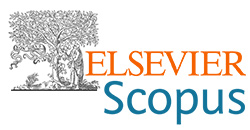Structural, microstructural, magnetic and dielectric properties of Fe2O3 modified CuO composite
DOI:
https://doi.org/10.62638/ZasMat1136Apstrakt
1-xCuO-xFe2O3 composites where x = 0.05, 0.10, 0.15 and 0.20 have been synthesized using ball milling mixing method. The structural, microstructural, elemental analysis, magnetic and dielectric properties of prepared ceramic composites have been investigated using the advanced characterization techniques. The influence of sintering temperature on structural, dielectric and magnetic properties have been investigated. The structural phase analysis has been carried out using X-ray diffraction and effect of sintering temperature clearly depicted in graphs. As increase in sintering temperature from 700 °C to 900 °C, diffraction peaks shift towards higher angles, indicating changes in crystal lattice parameters and potential crystal structure distortions. However, after careful consideration of the XRD results and a comprehensive analysis, we concluded that a synthesis temperature of 700 °C is preferable. The SEM micrographs shows an increase in grain size of ceramic composites as concentration of Fe2O3 increases. The Energy Dispersive X-Ray spectroscopy affirms presence of elements according to stoichiometric proportion whereas S-shaped M vs. H. loop confirms presence of magnetic ordering. Variation of Real (ε') and Imaginary (ε") parts of dielectric permittivity with frequency shows general dielectric behavior.
Ključne reči:
Composites, Ball milling mixing method, Dielectric properties, Magnetic propertiesReference
M.Fterich, F.B.Nasr, R.Lefi, M.Toumi, S.Guermazi (2016) Effect of concentration of hexamethylenetetramine in structure, microstructure and optical properties of CuO nanoparticles synthesized by hydrothermal route. Materials Science in Semiconductor Processing, 43, 114-122. https://doi.org/10.1016/j.mssp.2015.11.023
S.Heikal, H.M.Mokhtar, W.A.E.Ghany (2023) Effect of CuO addition on the structural, electrical and dielectric properties of the sodium borate glasses. Physica B: Condensed Matter, 667, 415142. https://doi.org/10.1016/j.physb.2023.415142
C.Oruç, A.Altındal (2017) Structural and dielectric properties of CuO nanoparticles. Ceramics international, 43(14), 10708-10714.
https://doi.org/10.1016/j.ceramint.2017.05.006
M.E.Grigore, E.R.Biscu, A.M.Holban, M.C.Gestal, A.M.Grumezescu (2016) Methods of synthesis, properties and biomedical applications of CuO nanoparticles. Pharmaceuticals, 9(4), 75-83.
https://doi.org/10.3390/ph9040075
K.S.Siddiqi, A.Husen (2020) Current status of plant metabolite-based fabrication of copper/copper oxide nanoparticles and their applications: a review. Biomaterials Research, 24(1), 1-15.
https://doi.org/10.1186/s40824-020-00188-1
W.Hao, P.Xu, L.Sun, E.Cao (2023) Influence of CuO addition on the sintering temperature and giant dielectric properties of (In0.5Nb0.5)0.05Ti0.95O2 ceramics. Ceramics International, 49(24), 40650-40658.
http://dx.doi.org/10.1016/j.ceramint.2023.10.046
E.Arulkumar, S.S.Shree, S.Thanikaikarasan (2023) Structure, morphology, composition, optical properties of CuO/NiO nanocomposite for electrochemical energy storage devices. Results in Chemistry, 6, 101087.
http://dx.doi.org/10.1016/j.rechem.2023.101087
O.I.Sallam, M.M. Atta, E.O.Taha, A.M.Elbasiony, A. M.A.Henaish, R.M.Ahmed (2023) Synthesis and modification of photoluminescence and dielectric properties of novel fluorophosphate glass by incorporating different transition metal oxides for optoelectronic application. Optical Materials, 136, 113413. https://doi.org/10.1016/j.optmat.2022.113413
M.E.Grigore, E.R.Biscu, A.M.Holban, M.C.Gestal, A. M. Grumezescu (2016) Methods of synthesis, properties and biomedical applications of CuO nanoparticles. Pharmaceuticals, 9(4), 75-84.
https://doi.org/10.3390/ph9040075
K.S.Siddiqi, A.Husen (2020) Current status of plant metabolite-based fabrication of copper/copper oxide nanoparticles and their applications: a review. Biomaterials Research, 24(1),1-15.
https://doi.org/10.1186/s40824-020-00188-1
S.Kumar, J.Pal, S.Kaur, R.Kaur, M.Singh, A.Singh (2018) The Effect of Aliovalent Pb2+ Dopant on the Magnetic and Magnetodielectric Properties of LaFeO3 Solid Solutions. Journal of Magnetism and Magnetic Materials, 467, 89-95.
https://doi.org/10.1016/j.jmmm.2018.07.037
M.Kumar, K.L.Yadav (2007) Study of dielectric, magnetic, ferroelectric and magnetoelectric properties in the PbMnxTi1−xO3 system at room temperature. Journal of Physics: Condensed Matter, 19, 242202.
https://doi.org/10.1088/0953-8984/19/24/242202
K.S.Cole, H.Robert (1941) Dispersion and Absorption in Dielectrics:-Alternating Current Characteristics. Journal of Chemical Physics, 9, 341–351. http://dx.doi.org/10.1063/1.1750906
S.Havriliak, S.Negami (1967) A complex plane representation of dielectric and mechanical relaxation processes in some polymers. Polymer, 3861(67), 90021-3.
https://doi.org/10.1016/0032-3861(67)90021-3
V.Prakasha, S.N.Choudharya, T.P.Sinhab (2008) Dielectric relaxation in complex perovskite oxide BaCo1/2W1/2O3. Physica B, 403, 103-108.
http://dx.doi.org/10.1016/j.physb.2007.08.015
A.K.Jonscher (1977) The Universal Dielectric Response. Nature, 267, 673-679.
https://ui.adsabs.harvard.edu/link_gateway/1977Natur.267..673J/doi:10.1038/267673a0







